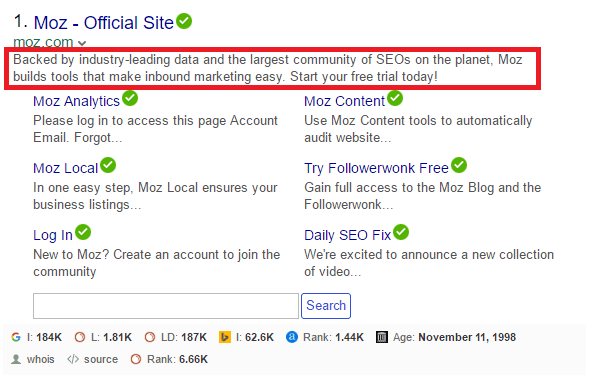Crafting the perfect meta description

If you’ve done a recent SEO audit of your site, you may have noticed the auditor mentioned your meta descriptions. The SEO auditor may say it’s not a huge deal to leave it as a snippet of text from your site, but don’t believe it. You’re actually missing a huge opportunity to harness organic traffic. In this post, we’ll walk you through what a meta description is, what it does, and how you can write the perfect description for your site.
What is a meta description?
A meta description is an attribute set in your site’s HTML, although many hosting companies, like WordPress, allow you to set the meta description of a page without entering code. It’s a brief description of what will be found on the page in question. Originally, meta descriptions were scanned by the SEO spiders and Bots to help search engines understand what was on your page and how to organize page rankings.
While that’s no longer the case due to keyword overloading practices in the late 90’s and early 2000s, meta descriptions still play an important role in web page performance. Meta descriptions are displayed in the search results and are your first opportunity to advertise to a searcher – an effective meta description lets your searcher know that this site holds the information they’re looking for, enticing them to click.
Take, for example, the SEO analytics company Moz. They have crafted their meta description to let you know who they are, what they do, and included an enticing offer for searchers.

Crafting a meta description
Now that you know what a meta description is and why it’s important, let’s talk about the do’s and don’ts of writing one.
How long should a meta description be?
A meta description should only be roughly one to two sentences. Every search engine has their own set character length they accept before they will cut off your text. Bing is the most strict, typically allowing only the first 150 characters to be viewed. Google allows for approximately 155 and Yahoo allows for 161. However, you cannot set a different meta description for each engine. A best practice to is to aim for the shortest allotment possible as it will render correctly on each engine in turn.
That being said, make sure your meta description isn’t too short, either. An optimal length is between 120-150 characters.
How many keywords should I use?
Keywords are really important in meta descriptions. When your meta description has keywords that match what the searcher used, they will be bolded. When a word is bolded, the eye is drawn to it, which increases the likelihood of a click. That being said, your meta description should be sentences and should not be a bunch of keywords. Keyword overloading is likely to cause searchers to skip your website, as it may appear to be fraudulent or spam.
Before crafting a meta description, take a look at your top performing keywords and compare them to the page. Then, select one to three keywords based on the overlap and content of the page. This strategy will allow you to optimize for keyword search but also maintain a quality meta description based on best practices.
What should it say?
The best meta descriptions describe the page, are action oriented, and solve the problem the searcher is experiencing. A meta description should allow the searcher to know immediately if this is the page they’re looking for and how you can help them.
In this day and age, people are beginning to care less and less about brand names, investors, and flashy logos. Truthfully, they care less and less about the company itself. Today’s buyers want to solve their own problems. They are focused on themselves and what they need. That’s why we cannot focus on ourselves, the language we want to use, or the message we want to say. We need to focus on what language the buyer is using in their search terms. You can promote language you’ve created all day but, if it’s not what prospects are actively using, you’re not going to get anywhere.
What do you mean by actionable language?
Do you have a free trial? Do you have a great demo available? Special offer to new customers? Tell them in your meta description, and tell them to take an action! By telling the searcher to take an action, you’re passing them the ball and making them an active participant in the relationship. “Start your free trial today!” “Get a one-on-one demo!” “Claim your new customer discount!” are all ways to make the searcher active. They can’t just continue scrolling because they’ve been given a decision to make. While they may not sign up for a demo that moment, giving them the information about this offer can often get them on your site. Getting them on your site is the hardest part and can lead to a conversion down the road.
Can I use the same meta description for each page?
No! Never use the same meta description for each page. Every page on your site is unique, therefore your meta description should be tailored for each page. They can be similar but should never be the same.
When every meta description is the same, it can cause the SEO bots to determine your page isn’t relevant for searchers. As a result, the bots may not display your page in the results, when it might be a perfect match. Furthermore, if a searcher sees a meta description that doesn’t line up with what they’re looking for, they’re much less likely to click on the page, leading to fewer site visits and fewer conversions.
Conclusion
Meta descriptions are your first opportunity at marketing to a prospective customer. When they do a search, that first impression is key. Don’t waste it! Make the most out of this opportunity by writing a specific, targeted meta description for each page on your site, taking into consideration your business goals and page content.
In conclusion, follow the tips above, and you’ll be able to create perfect meta descriptions for your site and business. Happy writing!
You Might Also Enjoy These Posts
Demand Generation vs Lead Generation
Gamification Strategies: Badges in B2B Marketing
Welcome To DemandZEN
DemandZEN specializes in Account-Based Demand Generation and solving the challenges around finding, engaging and converting target accounts into real opportunities for B2B Technology and Services companies.


